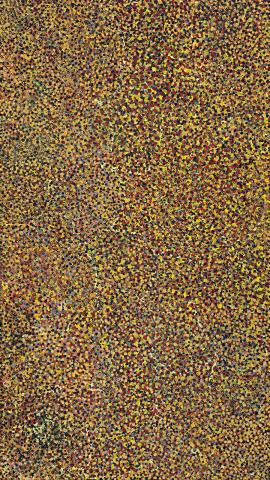AWELYE, 1991
Emily Kame Kngwarreye
synthetic polymer paint on canvas
228.0 x 129.0 cm
inscribed verso: artist's name, Delmore Gallery cat. 91K26
Delmore Gallery, Alice Springs
Private collection, Queensland
Our perception of landscape in art has expanded from the wide horizontal to include the hidden dynamics under the earth's surface. We now grasp the power of the revelatory Morning Star light drenching down through to the bottom of our water sources. Embracing a transparent and layered vertical view, we recognize its relationship to survival and sustainability. Such enlightenment has been marvelously enhanced by works such as Emily Kngwarreye's work, “Merne Everything” 1991—a gestural and coloured abstraction of what has been so fundamental to survival in this land.
This magnificent canvas is the earth at the food–gatherer's feet before rain. It is both the hidden potential of the future as well as today's sustenance. Moving under the parched surface is the yam's complex growth network. Overlaying this is a rich carpet of scarlet, creamy yellow, black and grey residual dry seeds, waiting to spring forth. This layering of immediate and potential food sources echoes Emily's familiar description, “merne everything” meaning “all food” of her country Alalgura (Alhalkere).
The energy of this canvas is transfused by the rain–makers' and other ceremonial energies of December 1991. The season's atmosphere was fuelled, as always, by the anxiety of a country reliant on unreliable rainpatterns. Custodians are called to “sing up” the season, raising hope and suspending breath.
The transformative power of thirsty country springing to life allows an understanding of the quiet reverence given to ceremony. Here, Emily's artistic expression is of belief in the strength of her spiritual life force, believing that she has maintained the fertility of her bush tucker sources, and in so doing, has passed on her knowledge to her custodial nieces.
Knowledge resides in Alalgura, an area of land that has allowed the Emu and its human co–habitants to flourish. The thick overlay of dots in “Merne Everything” represents the food that makes the Emu fat, allowing it to nurture its bustling chicks. The colours represented are important indicators of readiness to prepare and consume food—elementals of the life cycle. Emu mythology holds and reinforces the law and the passage of knowledge.
JANET HOLT
